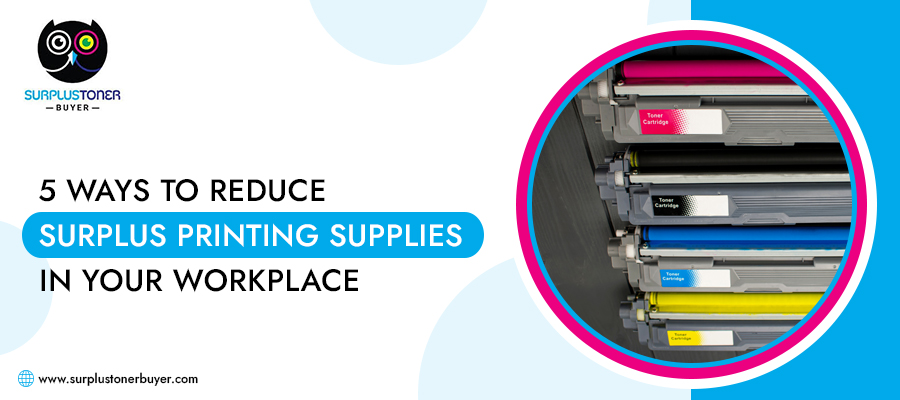
Ink cartridges, paper, and other printing materials often accumulate in your office over time, leading to surplus supplies that are never used. Not only does this waste valuable resources, but it can also take up unnecessary space in your workplace, increasing costs and contributing to environmental waste. Enter surplus ink cartridge buyers. This blog will help manage printing resources better and even turn surplus printer ink into a source of income by selling unused printer toner and cartridges.
Managing Surplus Printing Supplies
1. Track and Monitor Printing Usage
Many offices don’t track how much ink, paper, and other printing materials are used on a regular basis, which can lead to overstocking and waste. Don’t be like them- Implement a system to monitor printing activity, to better gauge how much your office really needs. Here are some practical ways to track usage:
-
Print Management Software
This software tracks how many pages are printed, what type of documents are being printed, and how much ink is consumed. It can also give you insights into who is printing the most and why, helping to identify areas for improvement.
-
Inventory Management
Keep a simple log of the supplies you have on hand and the frequency with which they are being used. This will allow you to prevent overordering and stay on top of stock levels.
2. Consolidate and Standardize Printer Models
One way to tackle this issue is to consolidate your printer models to a few standard options that use the same type of ink cartridges. By streamlining your printers and ink usage, you’ll be able to buy ink in bulk for fewer printer models, reducing the overall amount of surplus ink.
Benefits of Standardizing Your Printers:
-
Fewer Types of Ink Cartridges
Buying cartridges for just a few models means you’re less likely to accumulate surplus ink you can’t use.
-
Simplified Inventory
You’ll have better control over ink stock levels and avoid situations where certain ink cartridges expire or go unused.
-
Cost Savings
Bulk buying for fewer printer models can often lead to savings on ink and other supplies.
3. Sell Printer Ink That’s No Longer Needed

Over time, your office may accumulate surplus printer ink, either because printers have been replaced or because certain cartridges didn’t get used before the expiration date. Instead of letting these unused ink cartridges take up space or go to waste, consider selling them to certified surplus ink cartridge buyers at STB (Surplus Toner Buyer) where you can quote your own price and get paid at competitive rates. By selling your unused ink cartridges, you not only reduce surplus stock but also make a positive impact on your company’s budget and on the environment too.
4. Implement Eco-Friendly Cartridge Recycling Solutions
As more businesses adopt sustainability practices, recycling becomes an important way to manage surplus printing supplies. Eco-friendly cartridge recycling solutions are an excellent way to dispose of or repurpose used ink cartridges. These solutions help reduce environmental impact, avoid landfill waste, and ensure that resources are reused or refurbished.
Here are Some Eco-Friendly Options for Recycling Ink Cartridges:
-
Manufacturer Take-Back Programs
Many printer manufacturers, such as HP, Epson, and Canon, offer take-back programs where they accept used cartridges for recycling. Some even offer discounts on future purchases if you return your old cartridges.
-
Local Recycling Centers
Look for local recycling programs that accept ink cartridges. Many recycling centers are equipped to handle electronic waste and ink cartridges.
-
Third-Party Recycling Services
Numerous third-party companies specialize in recycling used printer ink and toner cartridges. They either refill and reuse the cartridges or break them down into recyclable materials, preventing unnecessary waste.
5. Educate Employees on Sustainable Printing Practices
One of the easiest ways to reduce printing waste and surplus supplies in your office is to educate employees on sustainable printing practices. Encouraging smarter printing choices can go a long way in decreasing unnecessary ink usage and paper waste.
Here are Some Tips to Share with Your Team:
-
Print Only What’s Necessary
Encourage employees to print only when absolutely necessary. Consider promoting a “paperless” office culture where digital documents are shared instead of printed.
-
Use Draft Mode for Internal Documents
When printing internal drafts, encourage employees to use the “draft” or “economy” printing mode to save ink.
-
Opt for Double-Sided Printing
Set printers to automatically print on both sides of the paper to reduce paper consumption.
-
Reduce Color Printing
Color ink can be significantly more expensive than black-and-white printing. Encourage employees to print in black and white unless color is absolutely required.
By fostering a culture of sustainability and mindfulness in your workplace, you can reduce unnecessary printing and, by extension, the surplus supplies you accumulate.
Conclusion
Surplus printing supplies can be a burden on both your office space and your budget, but with a few simple strategies, you can reduce waste and make your printing practices more efficient. By monitoring usage, consolidating printer models, selling unused ink to STB, adopting eco-friendly recycling solutions, and educating employees about sustainable printing, you can not only reduce surplus supplies but also promote a more environmentally friendly office.
Whether you’re looking to sell printer ink and toner for extra cash or explore eco-friendly cartridge recycling solutions, taking control of your printing supplies can save your business money and help you contribute to a greener future. Make your workplace more sustainable and cost-effective by calling on 855-418-6637 or drop us a message here and our team will get back at the earliest.
